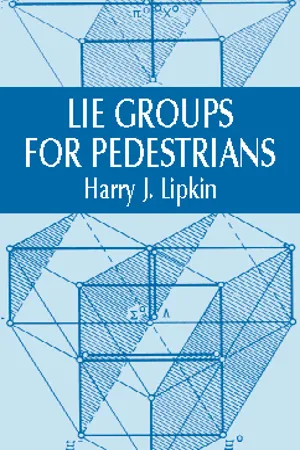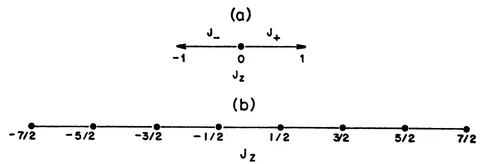Physicists have not yet learned to live with group theory in the same way as they have learned for other mathematical techniques such as differential equations. When an experimentalist or advanced graduate student encounters a simple differential equation in the course of his work, he does not run away and hide, worry about whether the solution to the equation really exists, or indulge in mathematical exercises of a ‘high-brow’ nature. He either solves the equation or goes to the literature and looks up the solution. On the other hand, many sophisticated theorists who are quite at home in the complex plane seem to be afraid of what might be called elementary exercises in group theory. This is all the more mysterious since many of these so-called group theoretical methods are in principle no different and no more complicated than certain mathematical techniques which every physicist learns in a course in elementary quantum mechanics; namely, the algebra of angular momentum operators.
The reason for this difficulty may be that physicists have still not made the separation analogous to that made for differential equations between those parts of the subject which belong to the physicist and those which belong to the mathematician. The standard treatment of group theory for physicists begins with complicated definitions, lemmas, and existence proofs which are certainly necessary for a proper understanding of group theory. However, it is possible for physicists to understand and to use many techniques which have a group theoretical basis without necessarily understanding all of group theory, in the same way as he now uses angular momentum algebra without delving deeply into the mysteries of the three-dimensional rotation group.
The purpose of this treatment is to show how techniques analogous to angular momentum algebra can be extended and applied to other group theoretical problems without requiring a detailed understanding of group theory.
1.1. REVIEW OF ANGULAR MOMENTUM ALGEBRA
Consider three angular momentum operators Jx, Jy and Jz which satisfy the well-known commutation rules
From these commutation rules it follows that there exists an operator
which has the property of commuting with all the angular momentum operators:
Since J2 commutes with all the operators, it commutes with any one of them, and one usually chooses the operator Jz. One can then in any problem find a complete set of states which are simultaneous eigenfunctions of J2 and Jz with eigenvalues usually designated by J and M. We use the conventional designation for these states
The remaining two operators Jx and Jy do not commute with Jz, but the following simple linear combinations
satisfy particularly simple commutation rules. Since J2 commutes with all the operators, we have
The commutators with Jz are also quite simple,
The commutator of each of these operators with Jz is just the same operator again, multiplied by a constant. It then follows that if either of these operators operates on a state which is a simultaneous eigenfunction of J2 and Jz with eigenvalues J and M, the result is another state which is an eigenfunction of J2 with the same eigenvalue J and which is also an eigenfunction of Jz, but with the eigenvalue M±1.
The value of the coefficient appearing on the right-hand side is easily obtained by a little algebra. This result and the trivial
define matrix elements for all of the angular momentum operators for all of the complete set of states.
Beginning with any particular state, |J, M〉, a set of states can be generated by operating successively with the operators (Jx+iJy) and (Jx–iJy). This process cannot be continued indefinitely because M can never be greater than J. Thus one finds restrictions on the possible eigenvalues of J and M, and obtains the well-known result that these may be either integral or half-integral and that for any eigenvalue J there corresponds a set or multiplet of 2J + 1 states all having the same eigenvalue of J and having values of M equal to–J,–J+1, ..., +J. The full set of states in a multiplet can be generated from any one of the states by successive operation with the operators (Jx±iJy).
Some of these features can be demonstrated simply in diagrams of the type shown in
Fig. 1.1. These diagrams are one-dimensional plots of the eigenvalues of
Jz.
Fig. 1.1a represents the operators (
Jx+i
Jy) and (
Jx–i
Jy) as vectors which change the eigenvalue of
Jz by ± 1, respectively.
Figure 1.1b illustrates the structure of a typical multiplet, in this case one with
J =
, in which a point is plotted for each value of
Jz where a state exists in the multiplet. The operation of any of the operators in
Fig. 1.1a on the states in the multiplet of
Fig. 1.1 b is represented graphically by taking the appropriate vector of
Fig. 1.1a , placing it on
Fig. 1.1b and noting which states are connected by this vector.
There are also well-known rules for combining multiplets. A system may consist of several parts, each of which is characterized by a multiplet having a particular value of
J. (An example of this would be the orbital and spin angular momenta of a particle.) These multiplets can be combined to form a multiplet describing the whole system. (For example, an orbital angular momentum of 2 and a spin of
for a particle can be combined to give a total angular momentum either of
or
.) Given the
J-values for the multiplets describing parts of the system, there are simple rules for deciding which possible values of
J occur for the total system, and there are algebraic techniques involving vector coupling coefficients for expressing the wave functions of the combined system which belong to a given multiplet. There is also one very simple rule which results from the different character of the multiplets having half-integral and integral values of
J. If two multiplets ...














